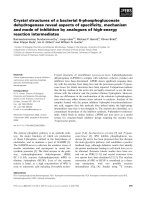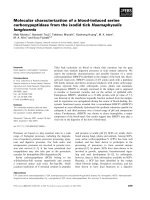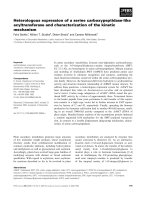báo cáo khoa học: " The presence of a lipoma in the Eustachian tube: a case report" pdf
Bạn đang xem bản rút gọn của tài liệu. Xem và tải ngay bản đầy đủ của tài liệu tại đây (1.1 MB, 3 trang )
CAS E REP O R T Open Access
The presence of a lipoma in the Eustachian tube:
a case report
Zhuofu Liu, Dehui Wang
*
and Quan Liu
Abstract
Introduction: The incidence of lipoma in the Eustachian tube is very rare, and to the best of our knowledge, has
not been reported in the literature. Tumors that form in the cartilaginous portion of the Eustachian tube can be
successfully removed by an endoscopic approach.
Case presentation: We report an incidentally-detected lipoma of the Eustachian tube in a 34-year-old Asian
woman with a six-year history of persistent otitis media in her right ear. Our patient underwent surgery five years
ago for the possibility of a choanal polyp, but her ear symptoms continued to be problematic following the
surgery. Our patient was examined at our hospital, and computed tomography revealed a well-defined, hypodense,
non-enhancing lesion involving the right Eustachian tube, measuring 1.6 × 2.4 cm. The mass was excised using an
endoscopic approach, and was found to originate from the cartilaginous portion of the Eustachian tube. The
tumor was sent for histopathologic evaluation. The postoperative course went smoothly, and our patient recovered
during follow-up over the next five months.
Conclusion: Lipoma of the Eustachian tube is very rare compared with other tumors. Improved radiologic
modalities aid the diagnosis of this benign tumor. Endoscopic removal of the tumor is possible and has helped in
early recovery.
Introduction
Lipomas are benign tumors and pre sent as painless soft
tissue masses commonly seen in adults [1]. They can
arise from many parts of the body, but are most com-
monly found in the subcutaneous tissue of the neck and
trunk. According to their location, they are also categor-
ized as subcu taneous, su bmucous or intramuscular lipo-
mas. Apart from fat cells, lipomas may also contain
other tissue components, such as fibrous, nervous or
vascular tissue [2]. Lipomas o riginating from the Eusta-
chian tube are extremely rare. Herein we report a case
of a lipoma arising from the Eustachian tube.
Case presentation
A 34-year-old Asian woman presented at our hospital,
with a six-year history of persistent right otitis media
with effusion. In addition, on presentation, our patient
was suffering from tinnitus and a sensation of ‘fullness’
in her right ear. Our patie nt underwent unilateral
myringotomy through the insertion of a pressure equali-
zation tube, wh ich was kept in place up until a few
months ago because the ear symptoms continued to
cause our patient problems. Five years previously our
patient was operated on at her local hospital for a neo-
plasmintherightnasopharynxduetoapossiblechoa-
nal polyp; the histological results of the neoplasm could
not be obtained. On this occasion, our patient presented
to our hospital with right nasal obstruction. Endoscopic
examination displayed a well-en capsulated, yellow-
colored tumor in the right side of her nasopharynx (Fig-
ure 1A). Contrast-enhanced computed tomography (CT)
was done, which showed a well-defined, hypodense
(relative to the surrounding muscle), non-enhancing
lesion involving the right Eustachian tube, measuring
1.6 × 2.4 cm (Figure 2A). Examination of our patient
rev ealed a tympanic membrane perforation on the right
side, and a T-tube was present in the right tympanic
membrane.
The mass was excised under general anesthesia by
endoscopy. Good exposure of the tumor was obtained
byremovalofpartofhermiddleturbinate,andthe
* Correspondence:
The Department of ENT, Eye, Ear, Nose and Throat Hospital of Fudan
University, Shanghai, 200032, China
Liu et al. Journal of Medical Case Reports 2011, 5:436
/>JOURNAL OF MEDICAL
CASE REPORTS
© 2011 Liu et al; licensee BioMed Central Ltd. This is an Open Access article distributed under th e terms of the Cre ative Commons
Attribution Licens e ( which permits unrestricted use, distribution, and reproduction in
any medium, provided the original work is properly cited.
tumor was subsequently removed completely. The
tumor was found to arise from the cartilaginous portion
of the Eustachian tube. The excised specimen showed a
well-encapsulated, yellow-colored tumor, with a soft
consistency and had the gross appearance of adipose tis-
sue. Histological examination confirmed the diagnosis of
fibrolipoma (Figure 3). Our patient was discharged the
day after surgery and received antibiotics for three days.
Two months after this surgery, endoscopic examina-
tion showed the nasopharynx with no sign of recurrence
of the tumor. The tympanic membrane perforation on
the right was healing. Five months later, a contrast-
enhanced CT scan showed no residual tumor (Figure
2B), and our patient had no tinnitus and no sensation of
‘fullness’ in her ear.
Discussion
Lipomas are the most common benign tumors, and are
derived from the mesenchyme. They a re composed of
mature adipose tissue, and several subtypes occur
when other mese nchymal elements are present [3], for
example fibrous tissue, nervous tissue or vascular tis-
sue. Histologically, lipomas can be classified as conven-
tional lipoma, fibrolipoma, angiolipoma, spindle cell/
pleomorphic lipoma, myxolipoma, chondroid lipoma,
osteolipoma or myolipoma [1]. Lipomas can be singu-
lar or multiple; small or of variable size; and sympto-
matic or asymptomatic. The majority of these benign
tumors are asymptomatic, and symptoms that do arise
are usually due to pressure effects on adjacent
structures.
The typical clinical presentation of tumors involving
the Eustachian tube consists of chronic ear drainage
with recurrent episodes of otitis media. This is caused
by the obstruction of the Eustachian tube by the tumor.
Upper a irway obstruction is a result of extension of the
tumor into the nasopharynx.
Tumors of the Eustachian tube may arise primarily
from within, or secondarily by invading it from sur-
rounding structures. These lesions include, amongst
others, tumors of dermoid cysts [4], teratoma [5], malig-
nant mucosal melanoma [6] and synovial sarcoma [7],
Here, to the best of our knowledge, we report the first
case of a lipoma originating from the Eustachian tube.
We found four cases of lipomas which were found to
arise from the middle ear [3,8-10], two of them invading
the Eustachian tube, and even extending to the naso-
pharynx. Lipomas have been characterized as showing
homogeneous fatty attenuation upon CT imaging, and
show different intensities according to the different
components they contain.
The surgical approach involving the Eustachian tube is
a d ifficult procedure due to the regional anatomy. Zoll-
ner [11] suggested a good approach to the tube via an
open mastoid cavity, or at least the tympanic entrance
of the bony part of the tube, which is used by many
Figure 1 Endoscopic examination showed a well-encapsulated ,
yellow-colored tumor in the right nasopharynx.
Figure 2 (A) Axial section of a contrast-enhanced CT scan
shows the hypodense, non-enhancing lesion (arrow) in the
right Eustachian tube. (B) Five months after surgery, axial section
of the contrast-enhanced CT scan at the same level shows no
residual tumor.
Liu et al. Journal of Medical Case Reports 2011, 5:436
/>Page 2 of 3
aural surgeons [3,4,9]. In 1969, House [12] designed the
middle fossa approach for Eustachian tuboplasty. How-
ever, this procedure is not widely accepted. With the
advent of transnasal endoscopic surgery, more and more
tumors located in the nasopharynx and lower part o f
the Eustachian tube have been treated in this way. Lin
[7] r emoved a synovial sarcoma from the lower portion
of the anterior cushion of the Eustach ian tube by trans-
nasal endoscopic surgery. For this case, an endoscopic
approach was the best choice considering the tumor was
contained within the cartilaginous portion of the Eusta-
chian tube and nasopharynx.
Conclusion
To the best of our knowledge, this is the first report of a
lipoma origina ting from the cartilaginous portion of the
Eustachian tube, and the tumor was removed success-
fully by an endoscopic approach.
Consent
Written informed consent was obtained from the patient
for publication of this case report and any accompany-
ing images. A copy of the written consent is available
for review by the Editor-in-Chief of this journal.
Authors’ contributions
ZL was the major contributor in writing the manuscript. DW performed the
surgery and helped in preparation of the final manuscript. QL did the
endoscopic examination and postoperative follow-up of our patient. All
authors read and approved the final manuscript.
Competing interests
The authors declare that they have no competing interests.
Received: 1 March 2011 Accepted: 6 September 2011
Published: 6 September 2011
References
1. Hameed M: Pathology and genetics of adipocytic tumors. Cytogenet
Genome Res 2007, 118(2-4):138-147.
2. Donley BG, Neel M, Mitias HM: Neural fibrolipoma of the foot: a case
report. Foot Ankle Int 1996, 17(11):712-713.
3. Edmonds JL, Woodroof JM, Ator GA: Middle-ear lipoma as a cause of
otomastoiditis. J Laryngol Otol 1997, 111(12):1162-1165.
4. Gourin CG, Sofferman RA: Dermoid of the eustachian tube. Otolaryngol
Head Neck Surg 1999, 120(5):772-775.
5. Forrest AW, Carr SJ, Beckenham EJ: A middle ear teratoma causing acute
airway obstruction. Int J Pediatr Otorhinolaryngol 1993, 25(1-3):183-189.
6. Tanaka H, Kohno A, Gomi N, Matsueda K, Mitani H, Kawabata K,
Yamamoto N: Malignant mucosal melanoma of the eustachian tube.
Radiat Med 2008, 26(5):305-308.
7. Lin HC, Friedman M, Kuo FY, Huang HY: Synovial sarcoma of the
Eustachian tube. Head Neck 2009, 31(9):1245-1248.
8. Abdullah V, Williamson P, Gallimore A, Shah NS: Middle ear lipoma. J
Laryngol Otol 1993, 107(12):1151-1152.
9. Stegehuis HR, Guy AM, Anderson KR: Middle-ear lipoma presenting as
airways obstruction: case report and review of literature. J Laryngol Otol
1985, 99(6):589-591.
10. Selesnick SH, Edelstein DR, Parisier SC: Lipoma of the middle ear: an
unusual presentation in a 4-year-old child. Otolaryngol Head Neck Surg
1990, 102(1):82-84.
11. Zollner F: Therapy of the Eustachian. Arch Otolaryngol 1963, 78:394-399.
12. House WF, Glasscock ME III, Miles J: Eustachian tuboplasty. Laryngoscope
1969, 79(10):1765-1782.
doi:10.1186/1752-1947-5-436
Cite this article as: Liu et al.: The presence of a lipoma in the
Eustachian tube: a case report. Journal of Medical Case Reports 2011 5:436.
Submit your next manuscript to BioMed Central
and take full advantage of:
• Convenient online submission
• Thorough peer review
• No space constraints or color figure charges
• Immediate publication on acceptance
• Inclusion in PubMed, CAS, Scopus and Google Scholar
• Research which is freely available for redistribution
Submit your manuscript at
www.biomedcentral.com/submit
Figure 3 High power of the specimen shows a lipomatous
lesion with some fibroblastic tissue (H&E, × 200).
Liu et al. Journal of Medical Case Reports 2011, 5:436
/>Page 3 of 3









